Greg O’s Garage: From the Helck Family Collection- The 1915 Panama-Pacific Expo and the 1915 Vanderbilt Cup Race
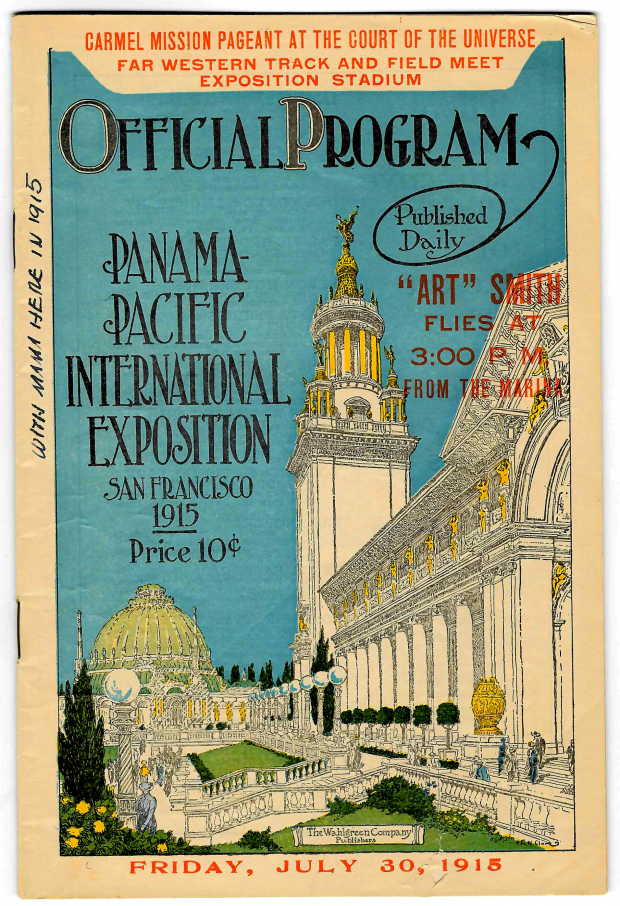
The official Pan-Pacific Expo Program found in the Helck Family Collection archives provides insights into the Expo and the 1915 Vanderbilt Cup Races.
In 1915, San Francisco hosted the Panama-Pacific International Exposition. The P.P.I.E. World's Fair also was the site of the 1915 Vanderbilt Cup Races for that year after leaving Long Island in 1910. Aside from being the World's fair, the P.P.I.E. celebrated two other significant events of the day, the rebuilding of the city after the great 1906 San Francisco earthquake, and the completion of the Panama Canal.
The following official program was collected by Peter Helck during his visit on Friday, July 30th, 1915.
Greg O.
Official program of the Panama-Pacific International Expo
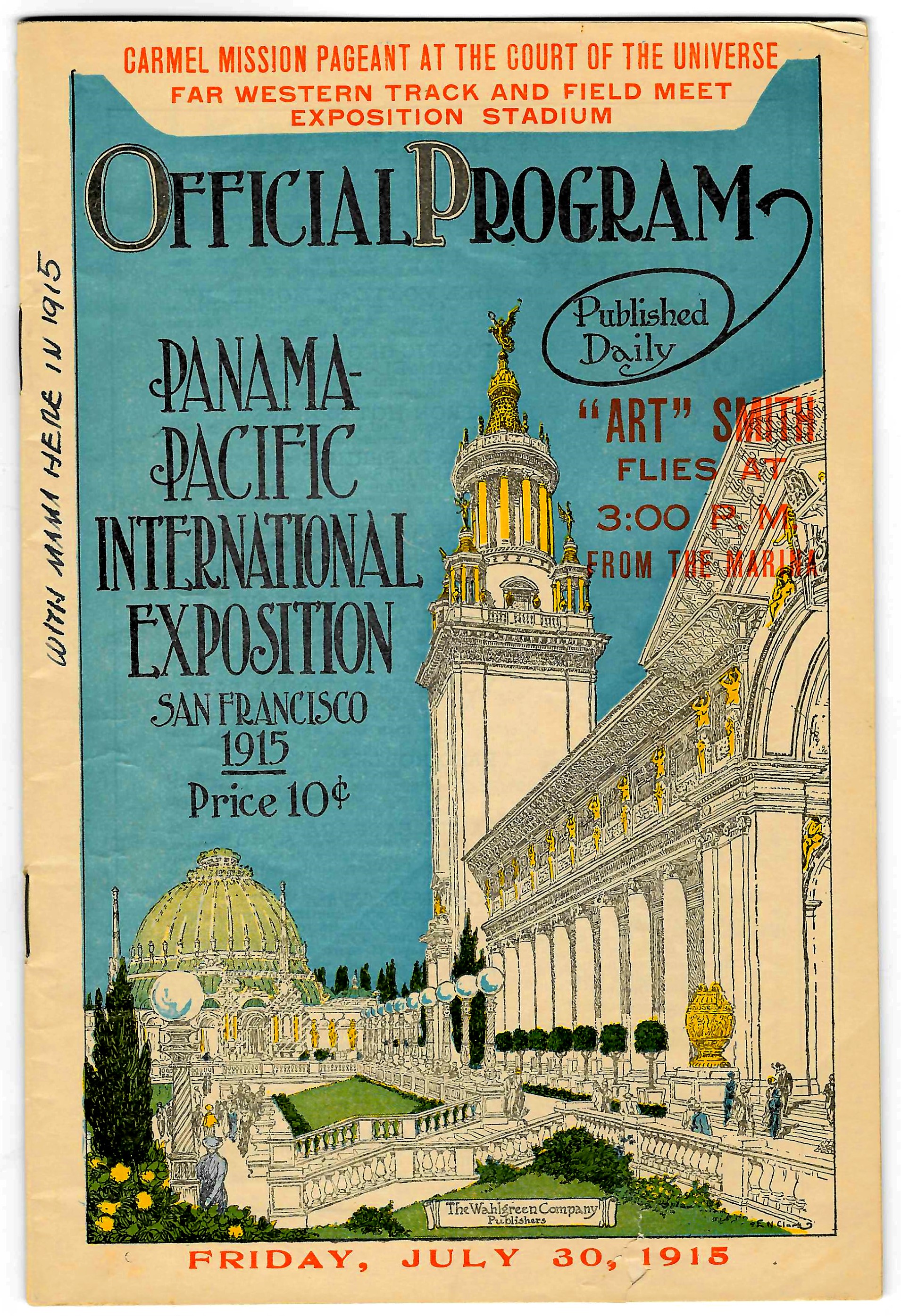
Every day, a new program for the year long Expo was printed to provide visitors insights into the Pavilions, grounds and more specifically, the unique events for the day.
Along the left side of the program is a hand-written notation from Peter Helck saying he was "with Mama here in 1915". Unfortunately for Peter, he missed the Vanderbilt Cup Races 4 months earlier.
The biggest event for the day was always stamped in the upper right side of these programs. On the day Peter visited, Art Smith was performing his usual aerial acrobatics at 3pm as noted on the front.
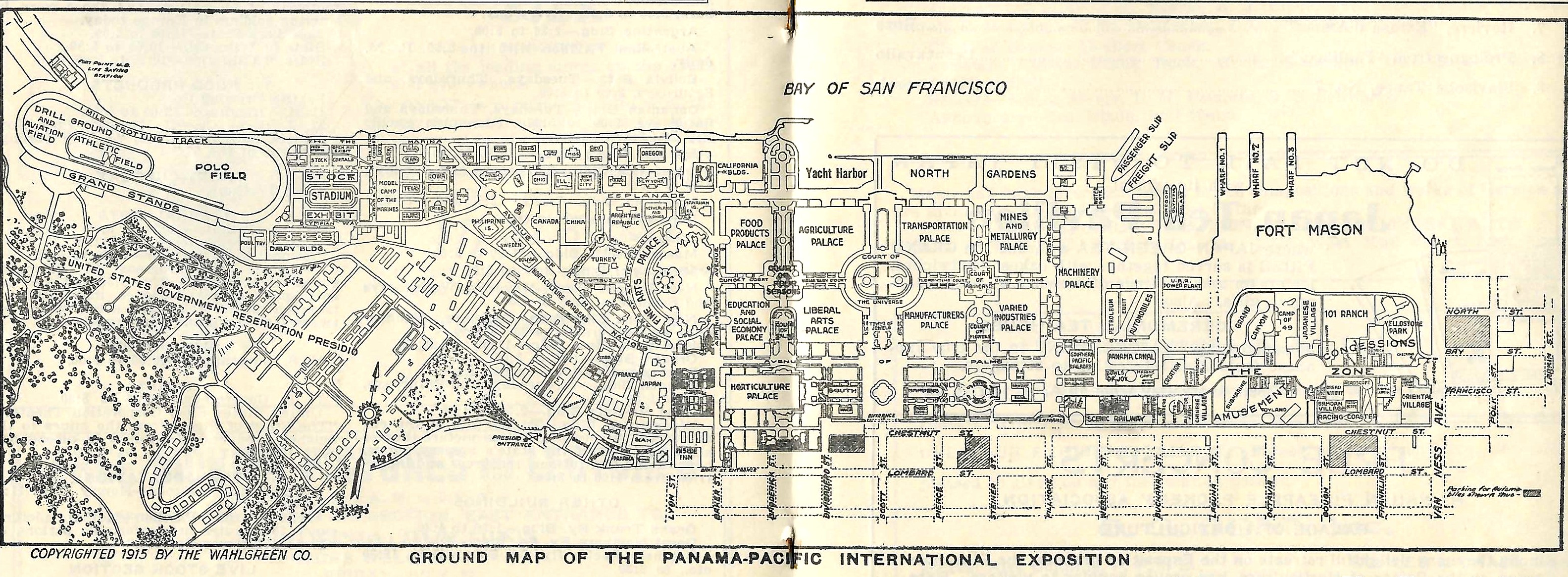
Like all World's Fairs, the expansive grounds were packed with pavilions, industry palaces, exhibits and restaurants from around the world.
Within some of the industry palaces new technology ranged from Henry Ford's auto assembly lines, transportation, agricultural, educational, advancements and even a display of the new, breakthrough infant incubator which went on to save may infant's lives.
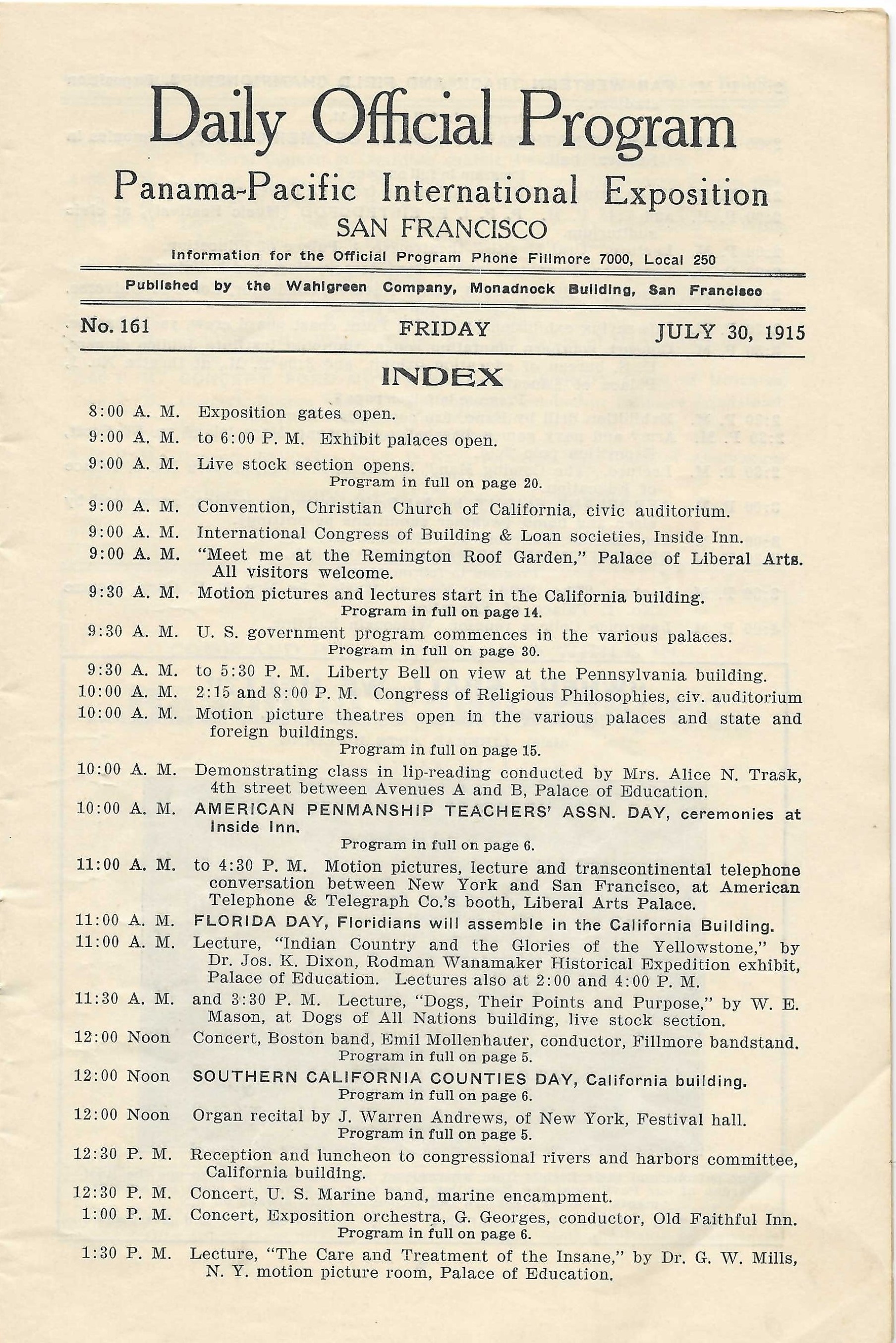
The day's events for July 30th.
The Liberty Bell was specially transported to the expo and displayed. Here noted as being available for viewing between 9:30am- 5:30pm.
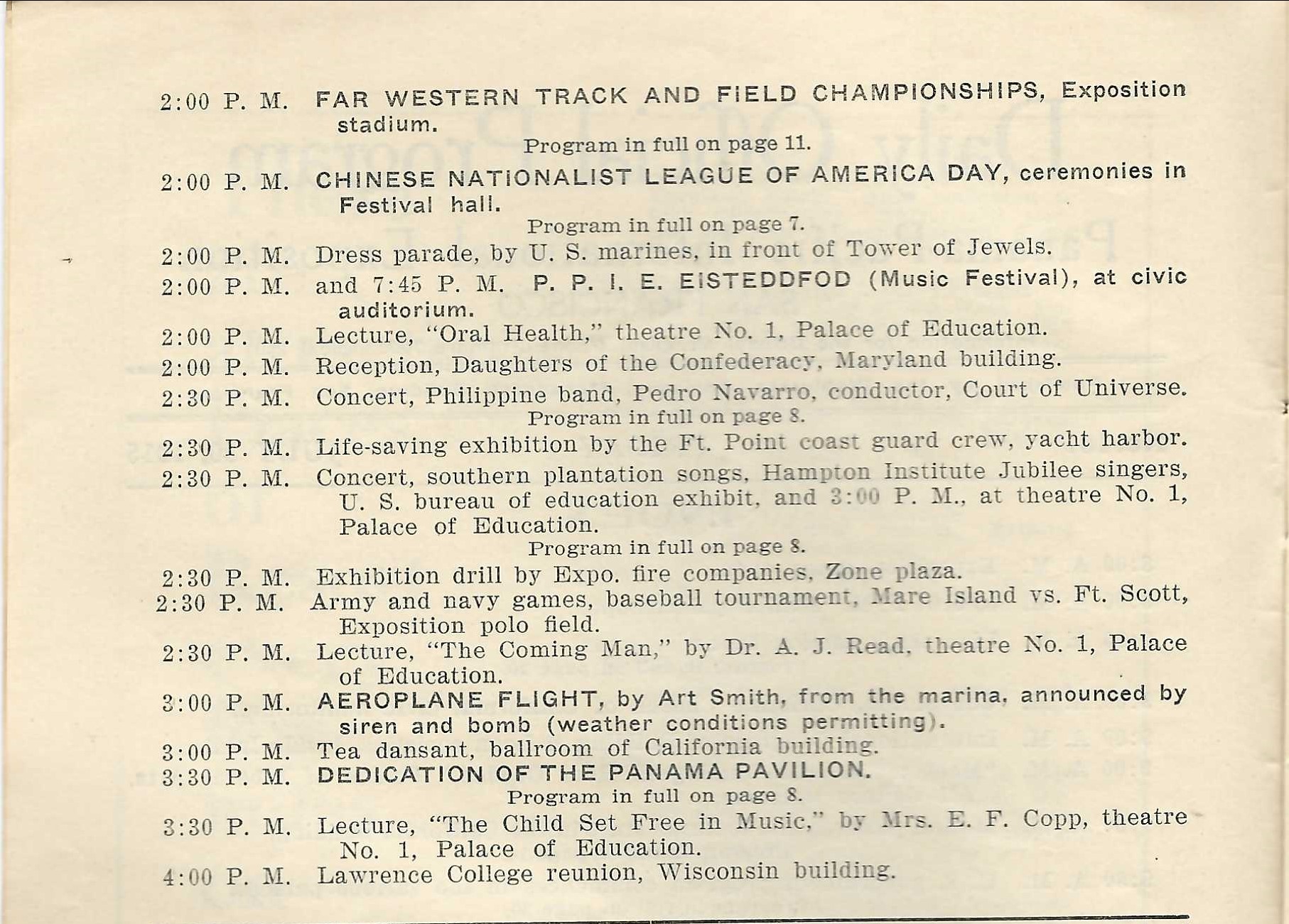
A 2pm lecture on 'Oral Health" at the Palace of Education. Necessary in 1915.
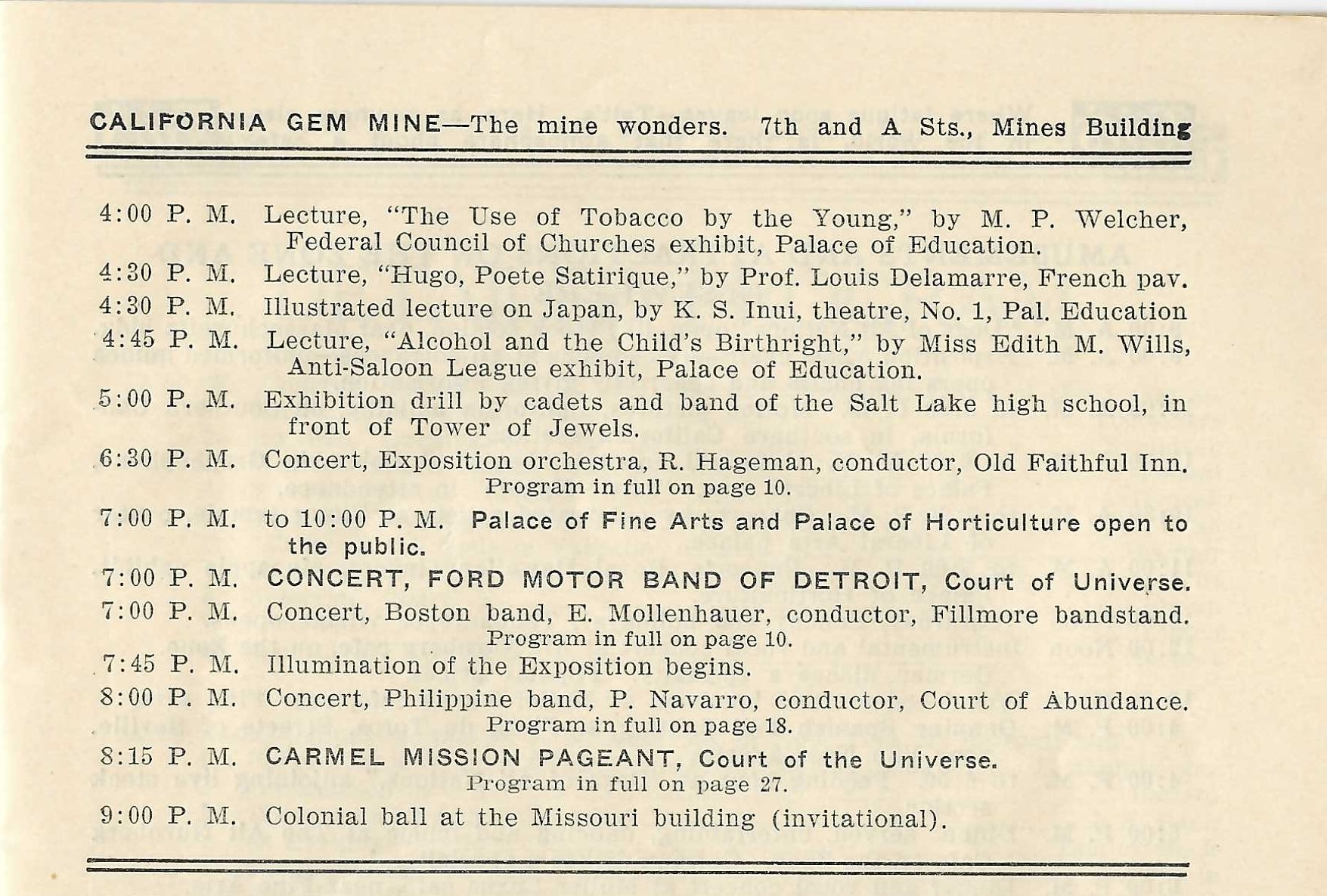
A 4pm lecture on 'The use of tobacco by the young'? And a 7pm concert by the Ford Motor Band of Detroit.
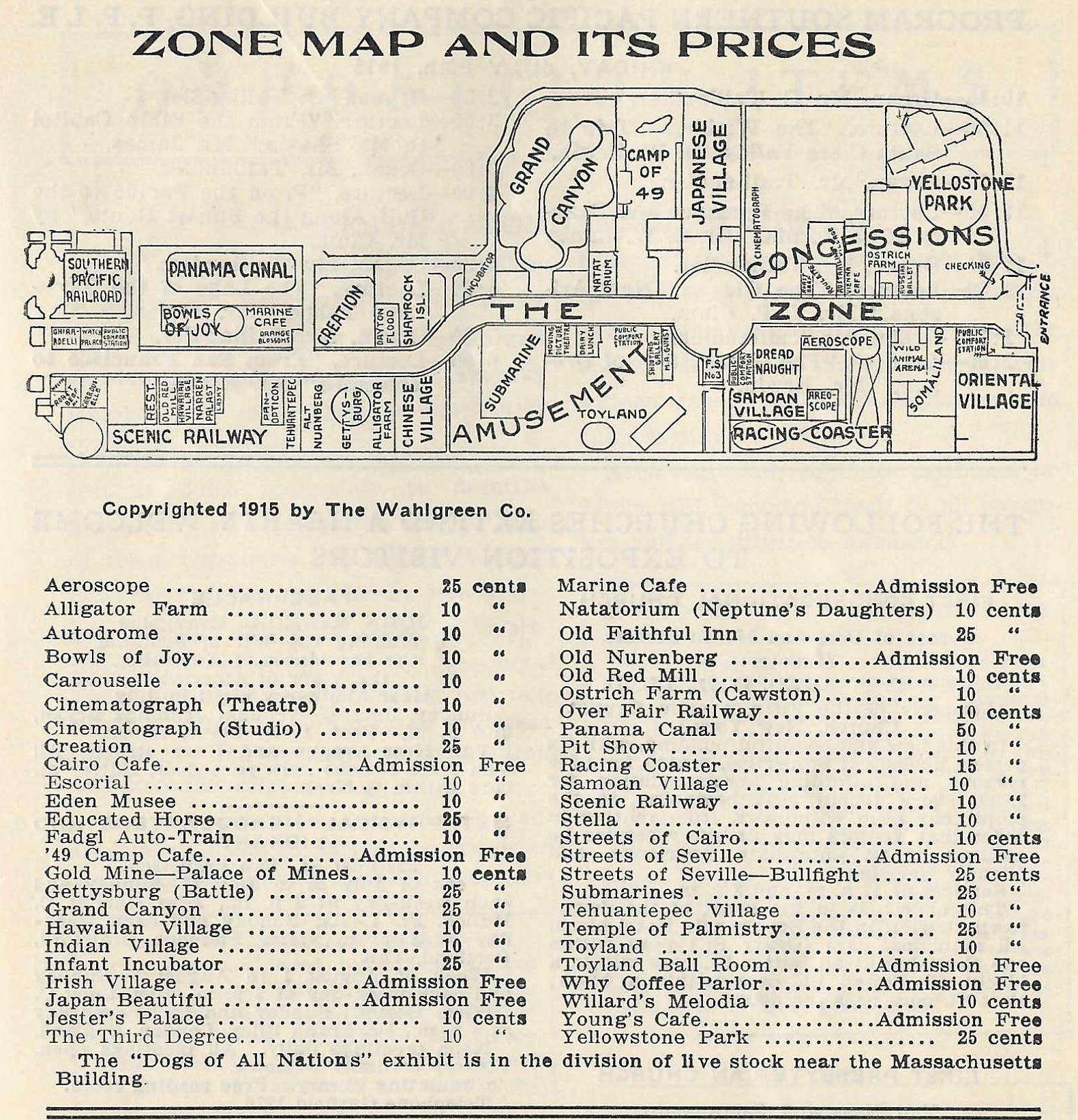
Map of the various zones and their associated prices to view them.
Various Palaces, Pavilions and Structures of the Expo
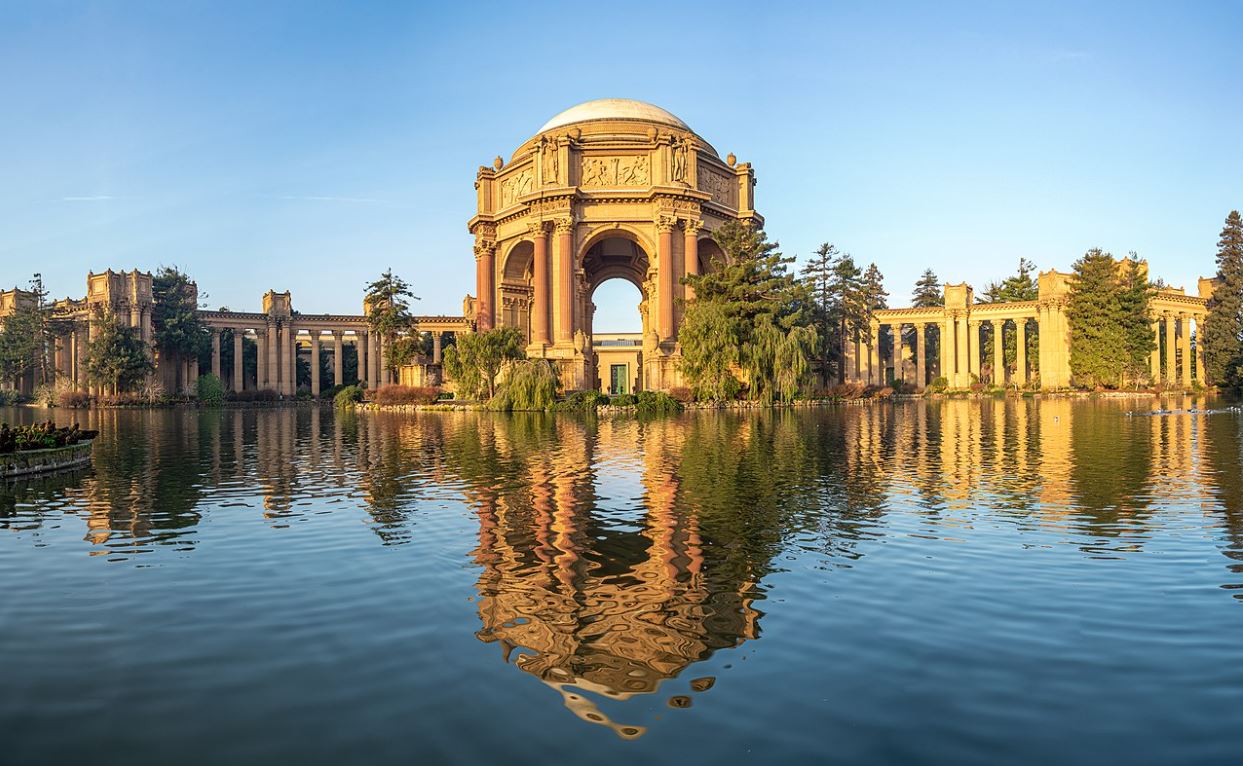
The Palace of Fine Arts. The only temporary structure to stay after the end of the Expo. The most beloved structure of the Expo was requested to be retained by the Palace Preservation League spearheaded by philanthropist Phoebe Apperson Hearst, mother of newspaper owner William Randolph Hearst.
Originally temporarily constructed of a wood frame covered in burlap and plaster, it surprisingly lasted until 1964. At that time, crumbling, dangerous and in need of extensive repair, it was completely torn down and an exact replica built in its place with permanent steel reinforced concrete as seen in this current photo. Today, it is a beautiful park in the Marina District with 2003 and 2010 seismic retrofitting to resist California's ever present earthquake threats.


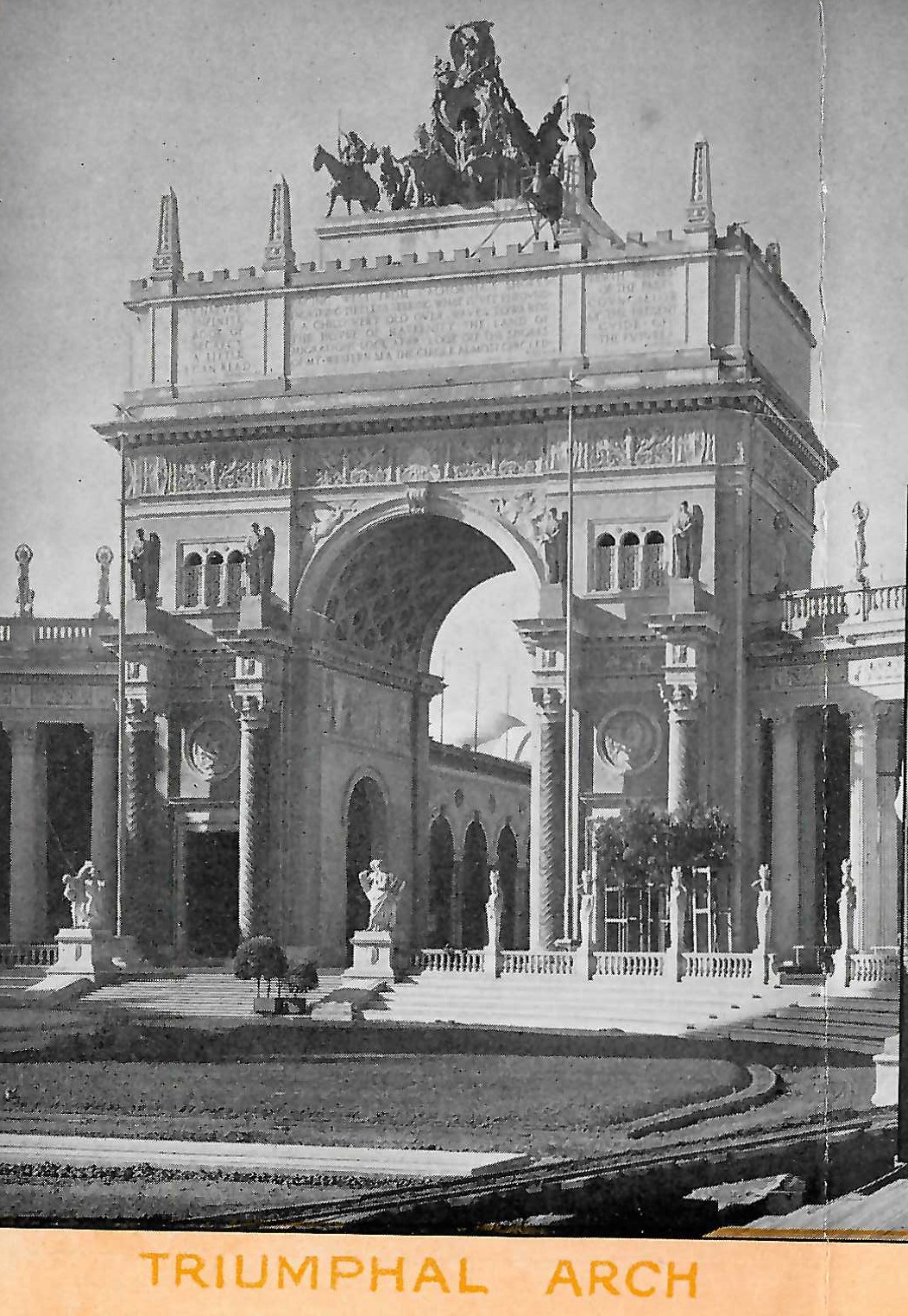
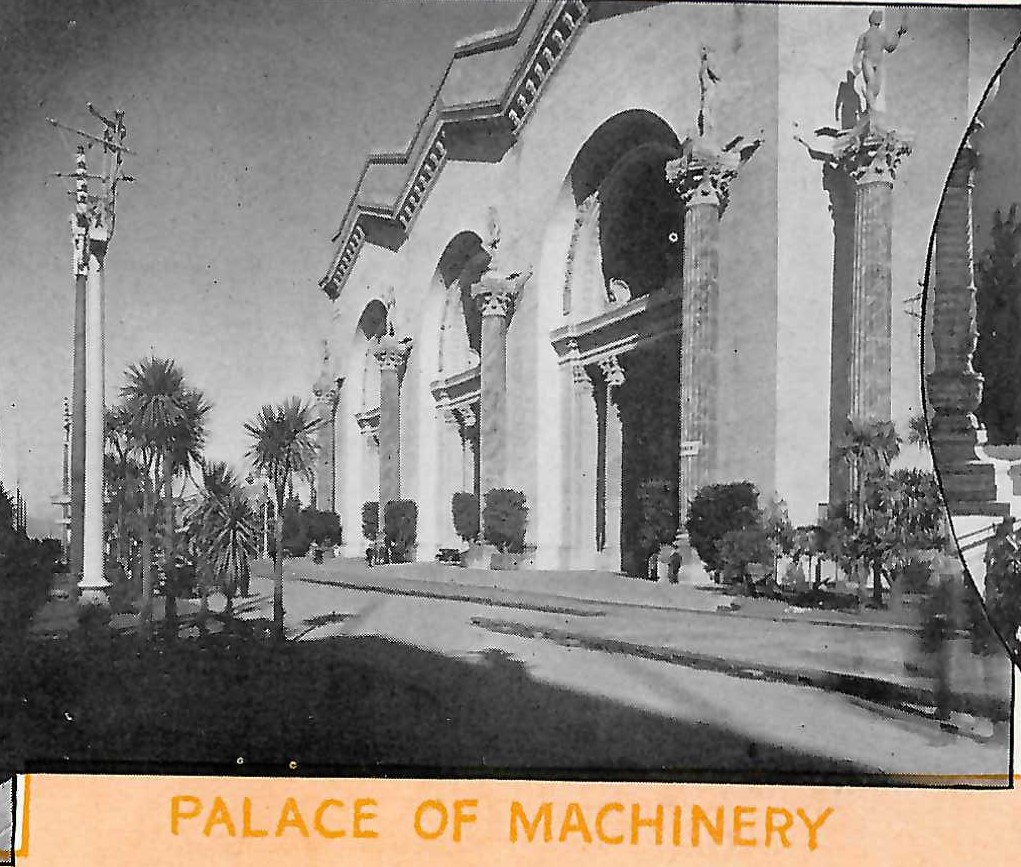
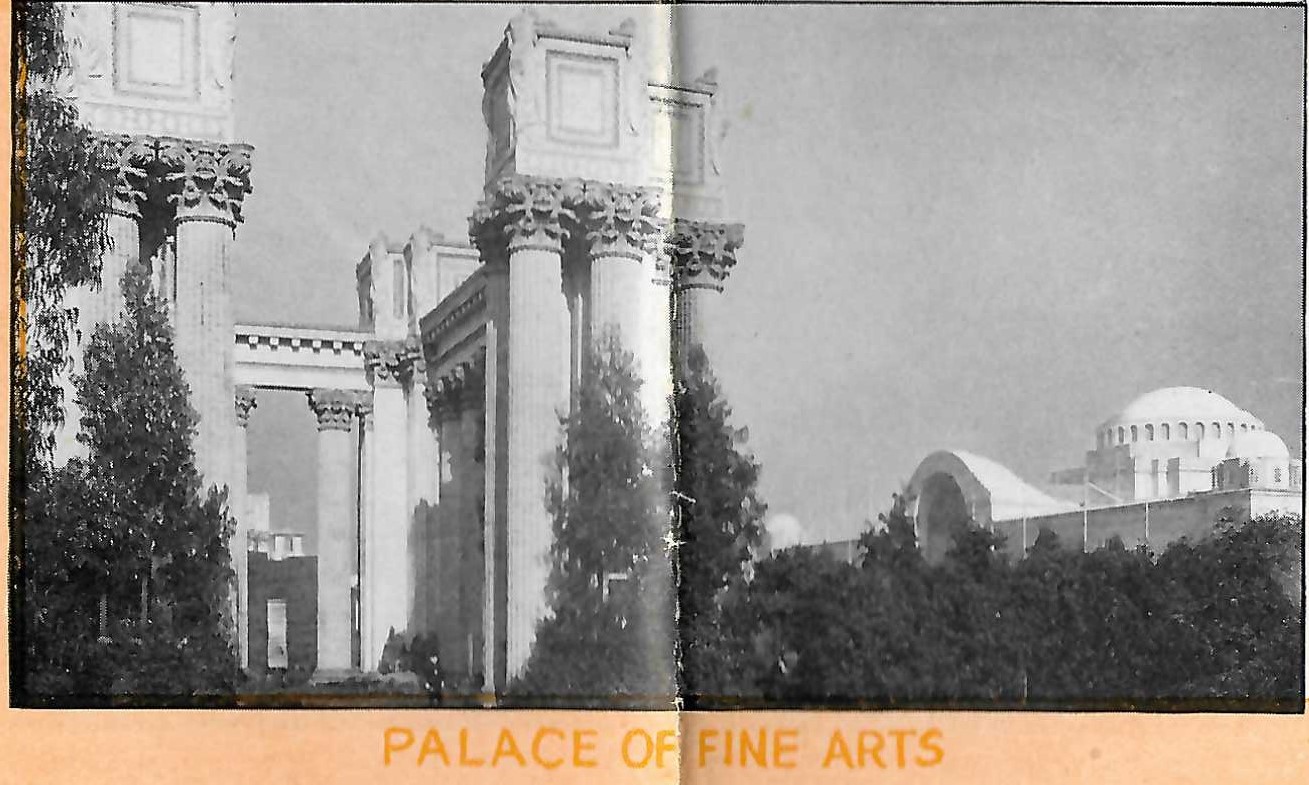
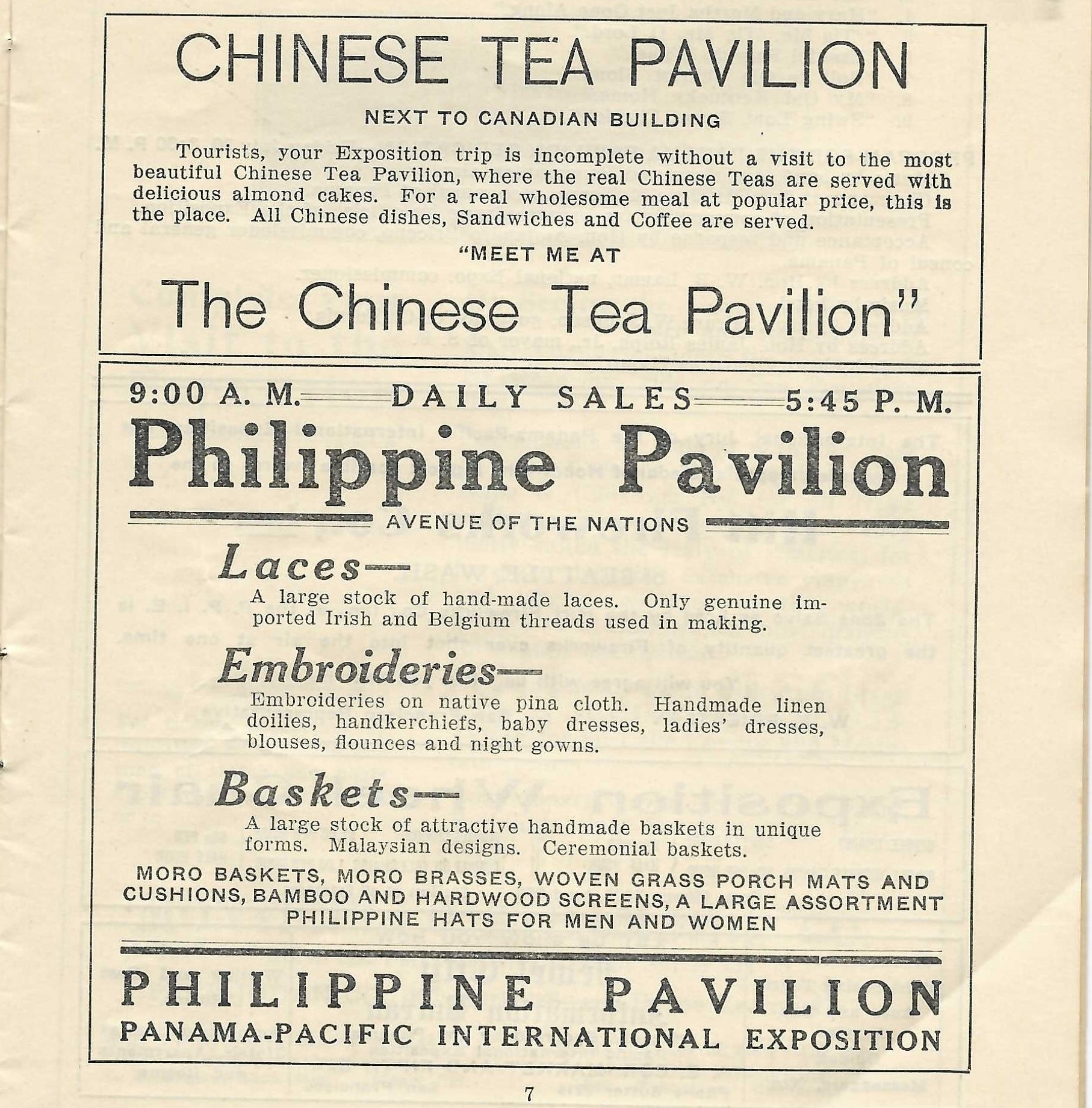
Chinese and Philippine Pavilions
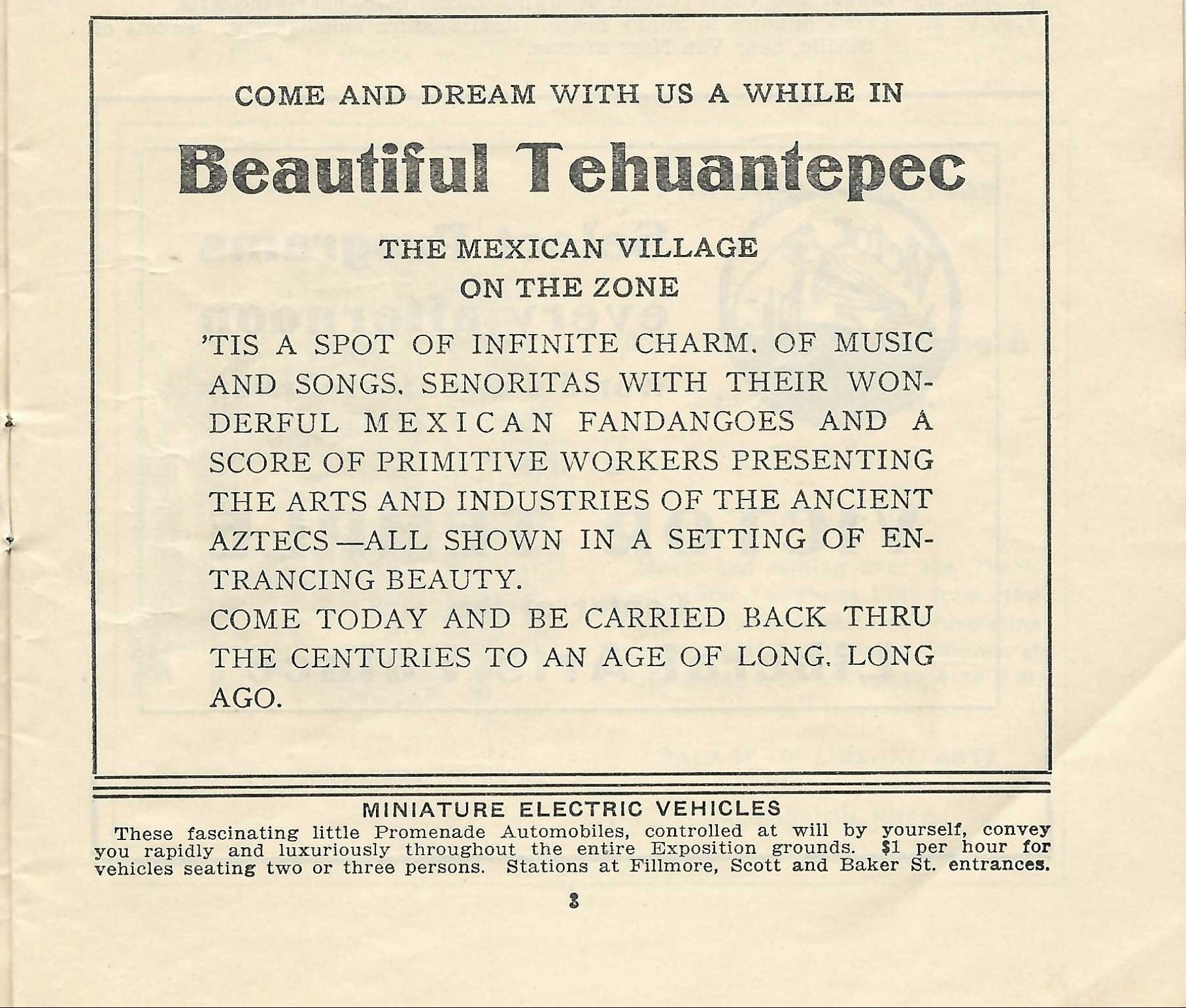
Mexican Village
At the bottom of many pages throughout the program were ads for miniature electric vehicles to rent for one dollar per hour to use to travel through the expo. Basically, golf carts before they were known as such.
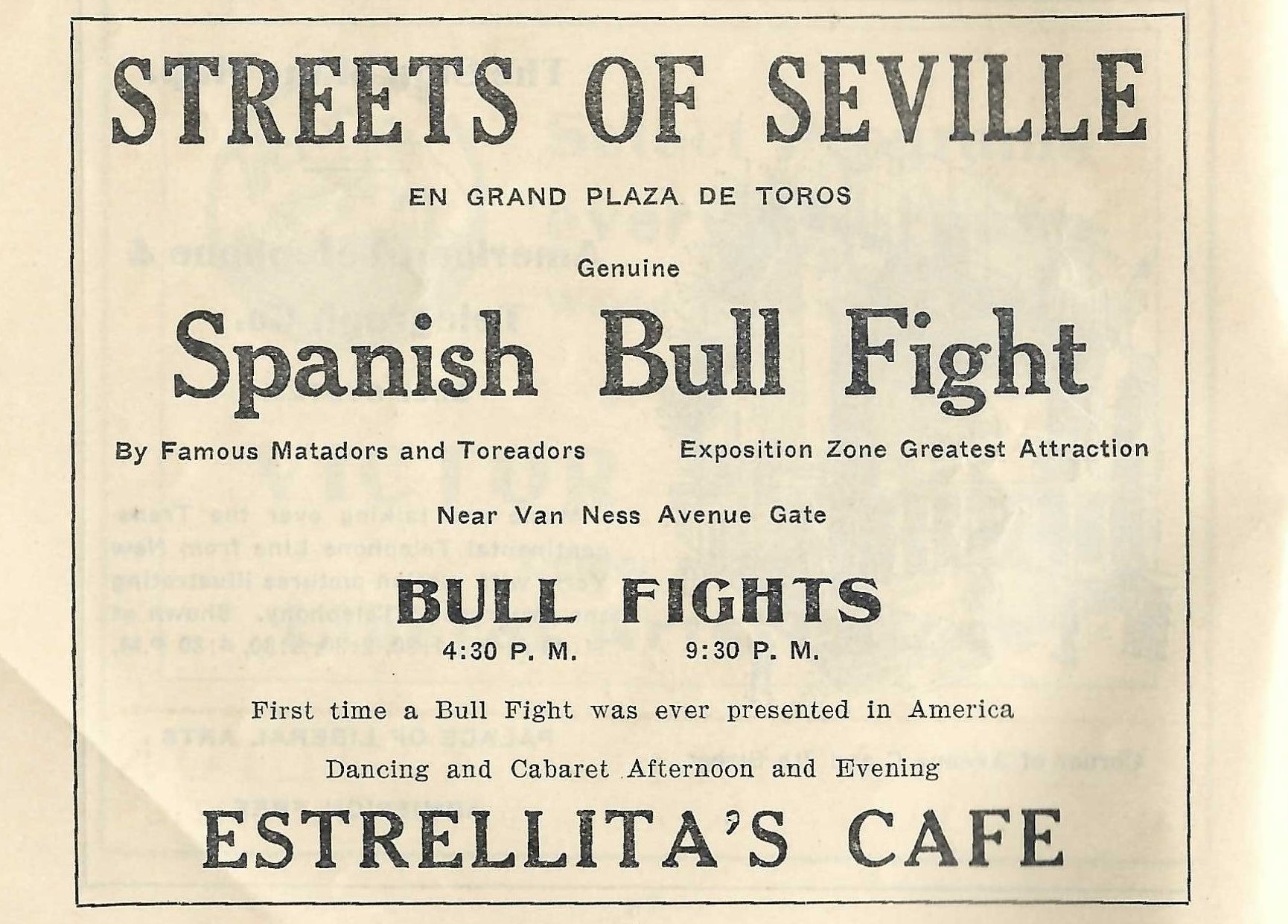
Spanish bull fights delighted crowds
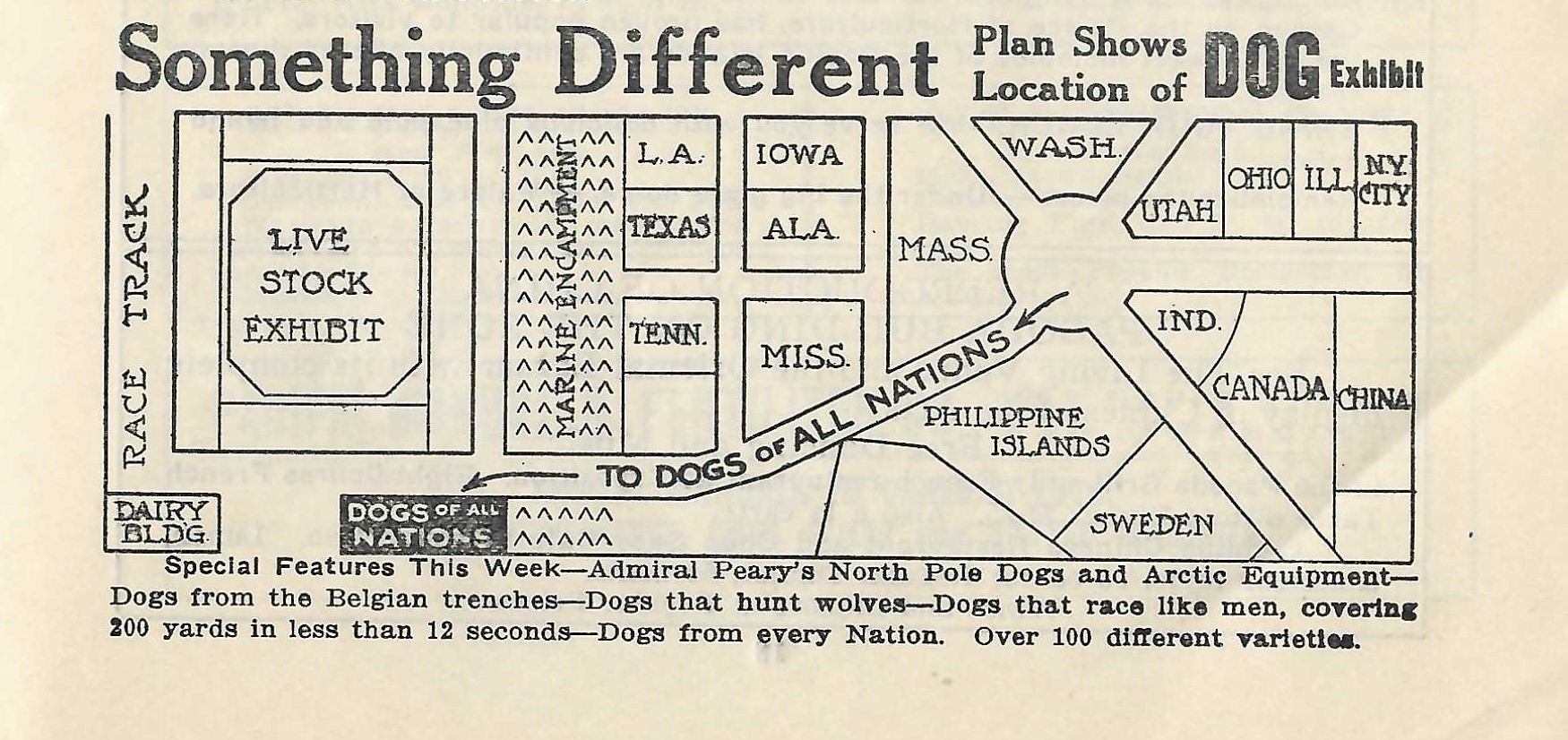
The dog exhibit promised a view of Admiral Peary's North pole dogs and Arctic equipment
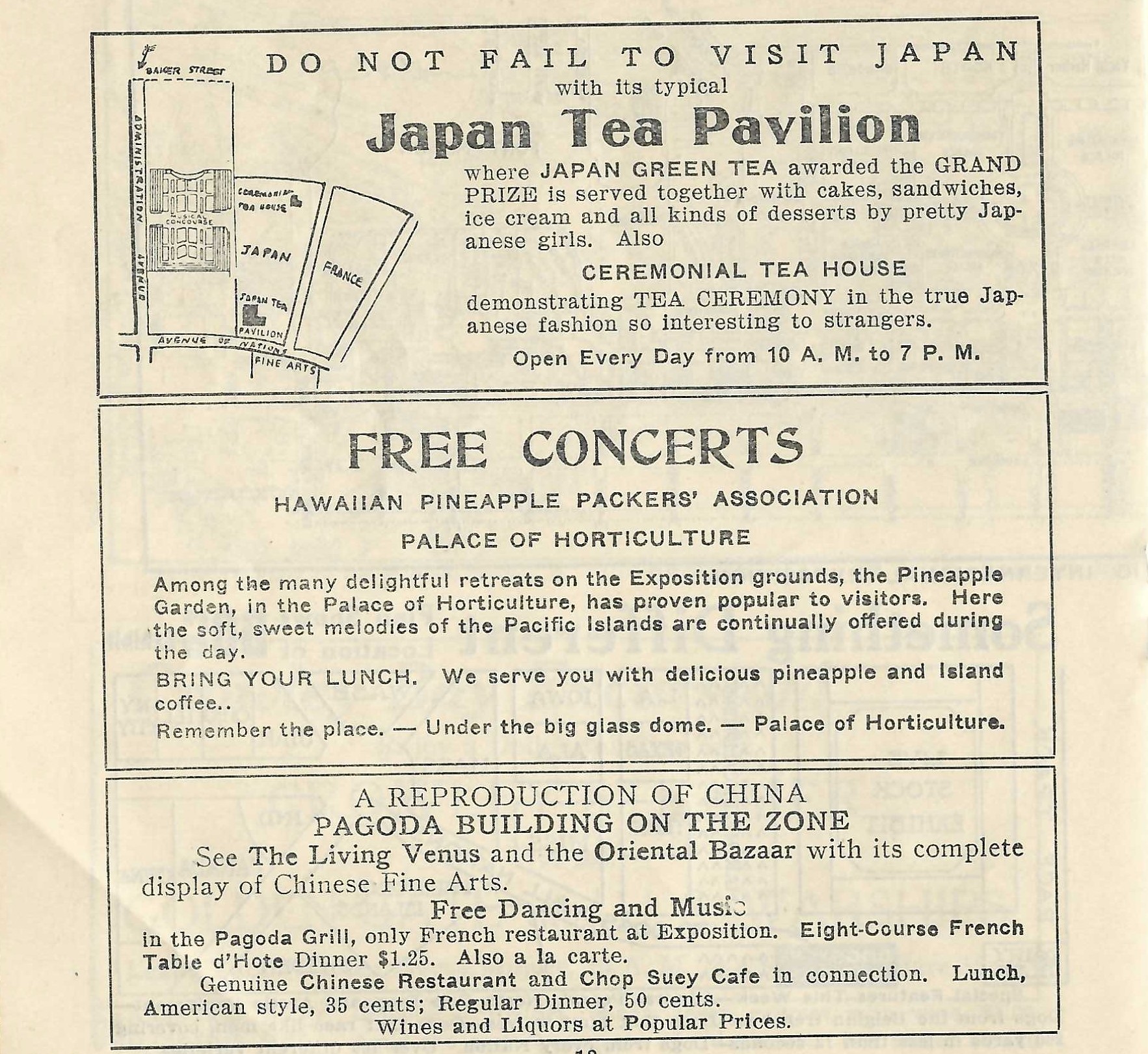
Japan Tea Pavilion
The site of the Expo
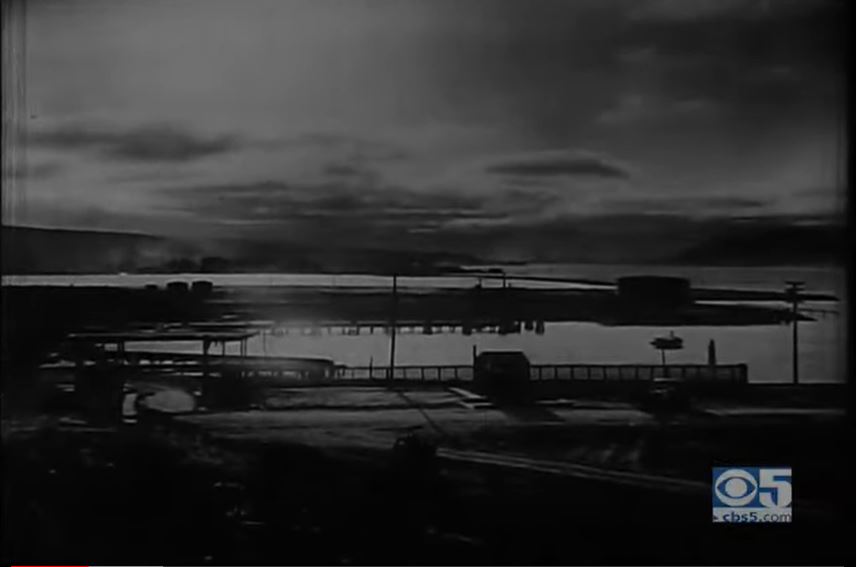
Prior to the Expo in 1915, this is a view of the swampy, useless area. After the 1906 quake, building rubble and dredged sand from the harbor were used to create the land that the expo and eventual Marina District neighborhood were to be built. This proved to be a big problem for structures to built there in the future.
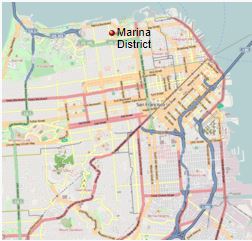
After the Expo, the site on the north side of the city was sold off to developers, torn down, rebuilt with town house homes, and is now the Marina District.
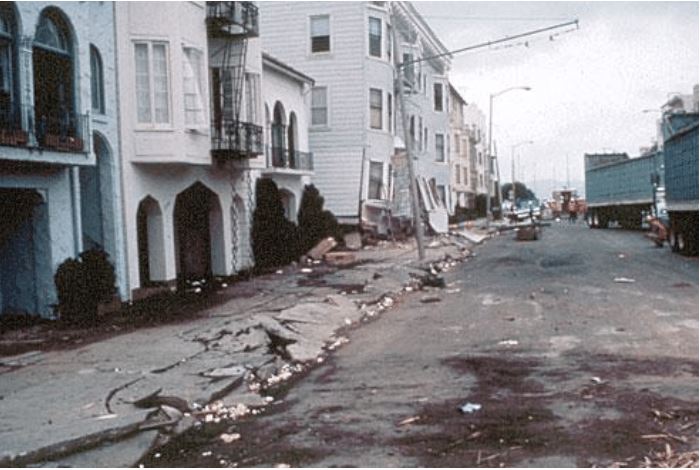
The composition of rubble and sand turned out to be very problematic when on October 17th, 1989, the Loma Prieta earthquake struck with a magnitude of 6.9 on the Richter Scale. Soil liquefaction caused much of the Marina District to be destroyed. Since then, the entire Marina District has been rebuilt to its original 1920's appearance with retrofitting to address the soil problems.
The 1915 Vanderbilt Cup race images
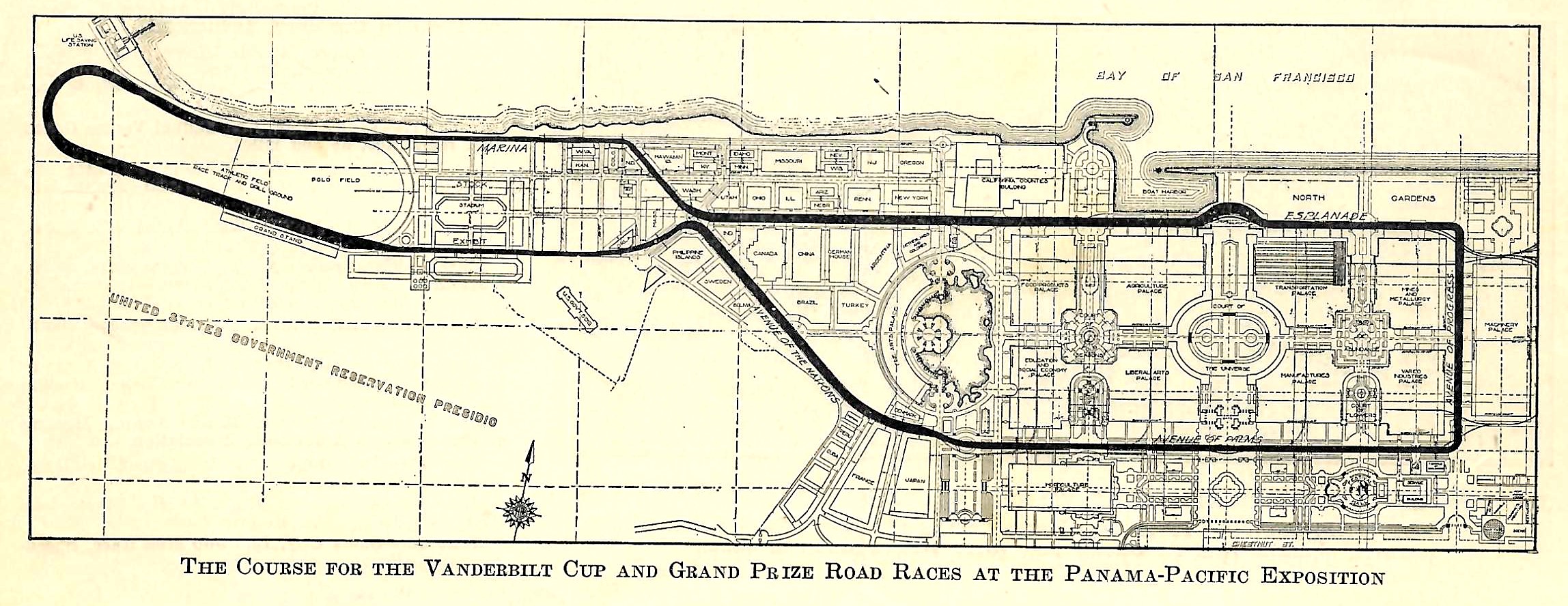
Adding to the excitement of the P.P.I.E. was the 1915 Vanderbilt cup Races.
3.848 mile course with 77 laps for a race total of 300.685 miles
Here the course be seen running through the streets of the Expo with a portion running on the track built in the western portion of the property.
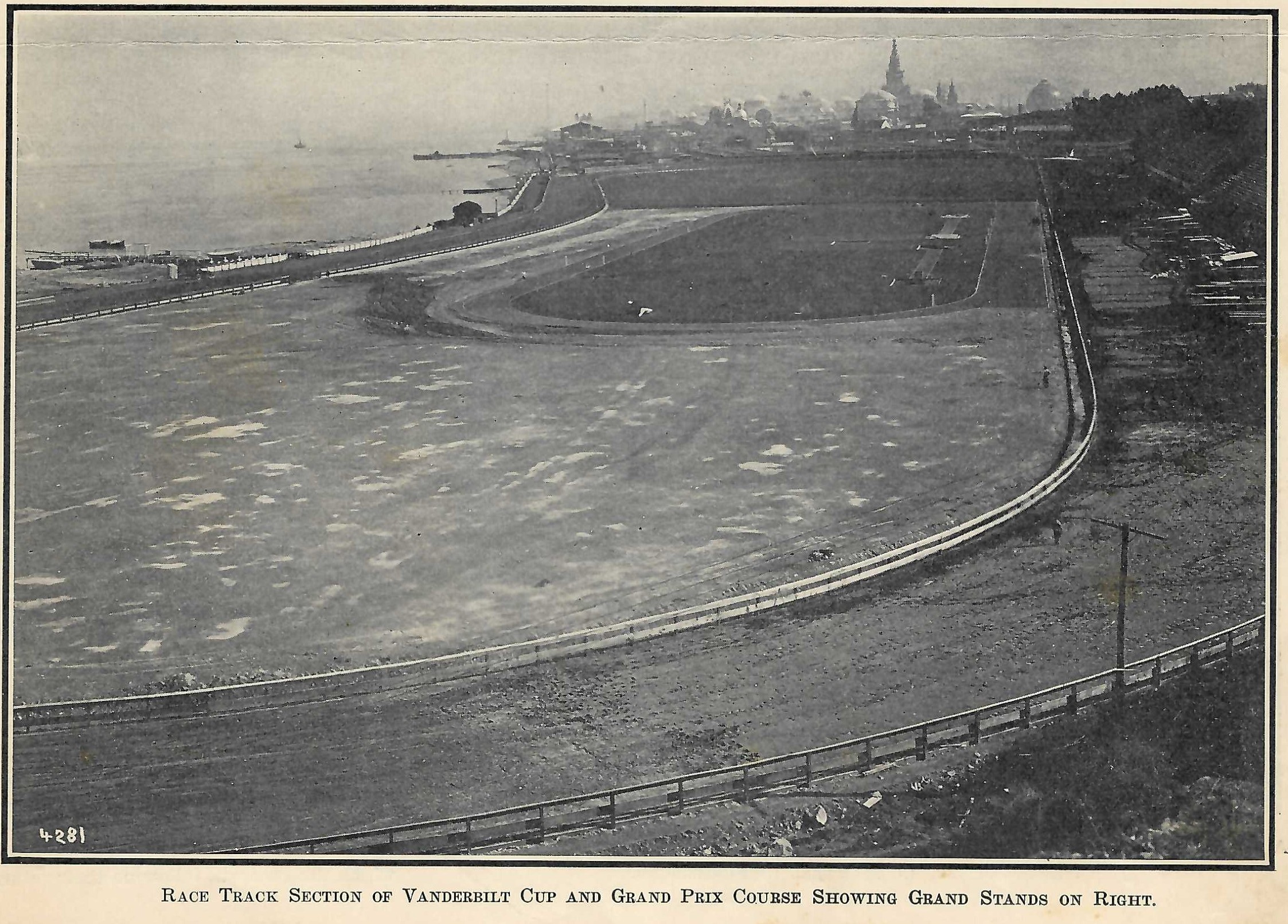
Aerial of the built racetrack.
Horseless Age Feb 17th, 1915
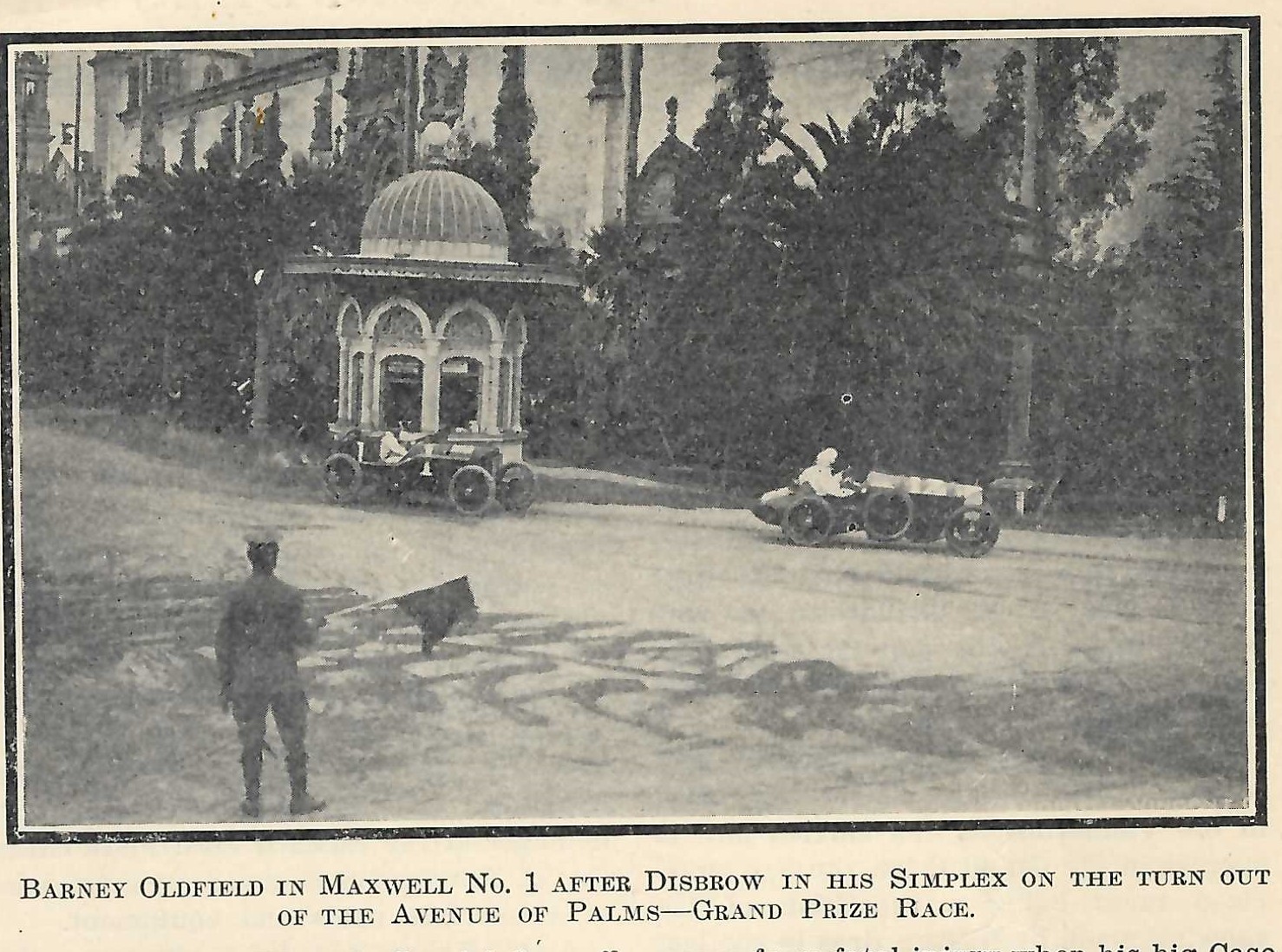
Barney Oldfield in his Maxwell following Louis Disbrow's Simplex through a turn
The Horseless Age March 10th, 1915
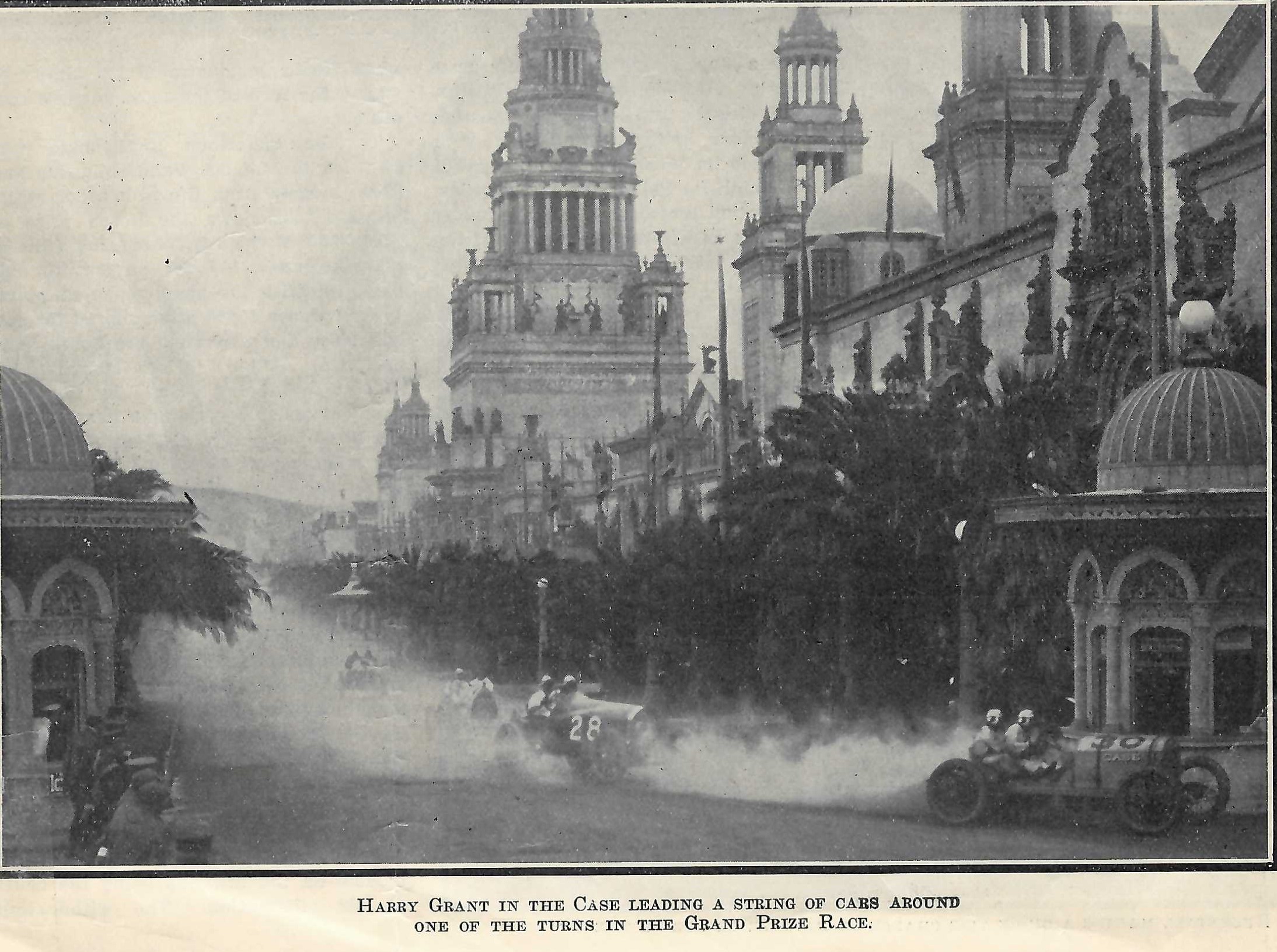
Not Harry Grant. This incorrectly captioned photo is actually Bob Burman in the #30 Case being followed through a turn by Hughie Hughes in the #28 Fiat.
The Horseless Age March 10th, 1915
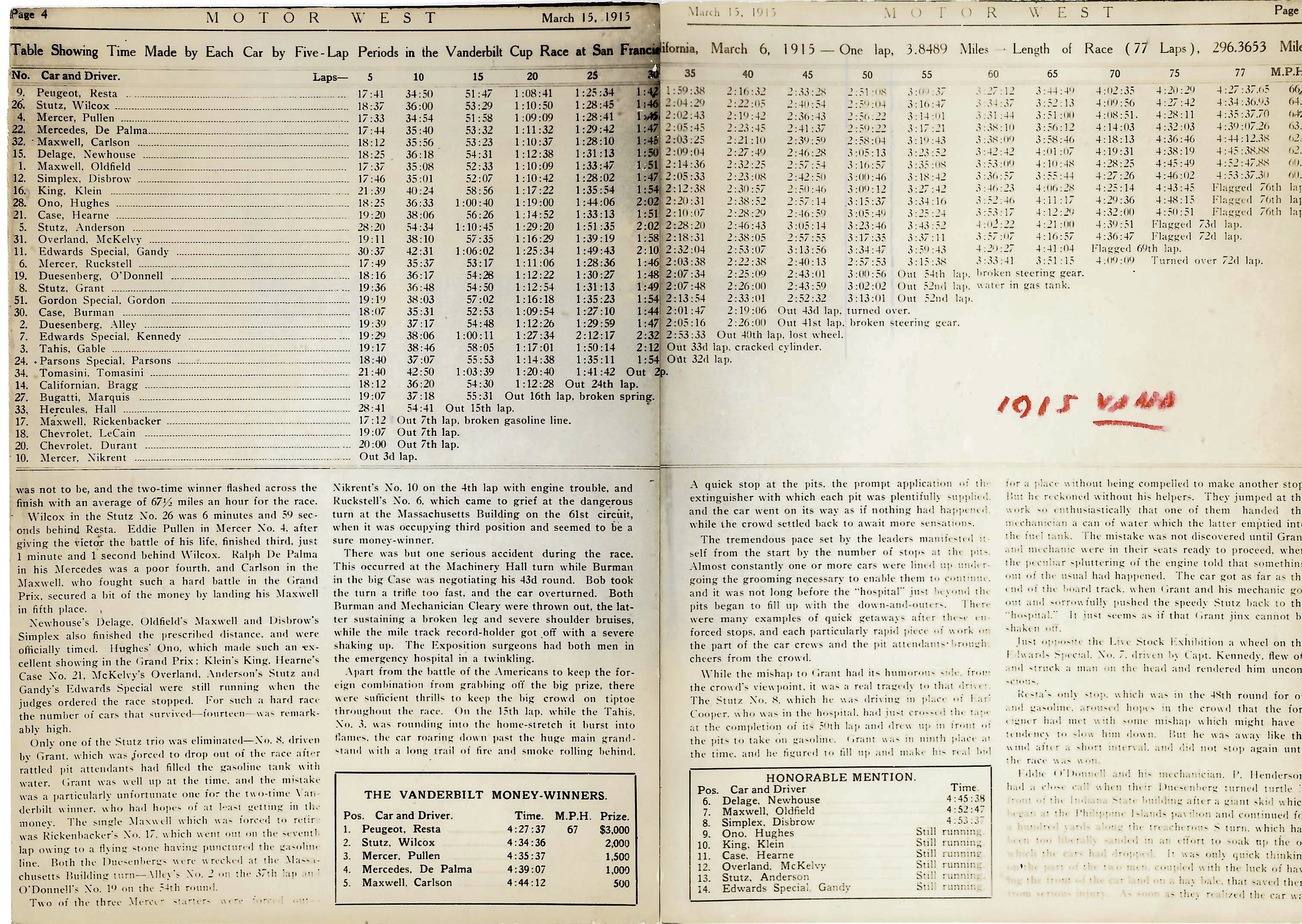
Results of the Cup race
Motor West March 15th, 1915
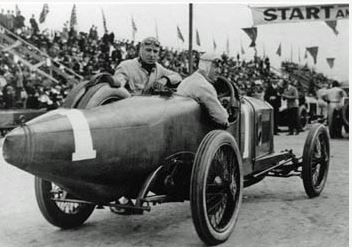
Winner of the 1915 and 1916 Vanderbilt Cup Races Dario Resta in his 115hp Peugeot with a time of 4 hours 27 min and 37 seconds at an average of 66.4 MPH.
Seen here with the same car at the 2016 Vanderbilt Cup races
photo courtesy of Harold Osmer
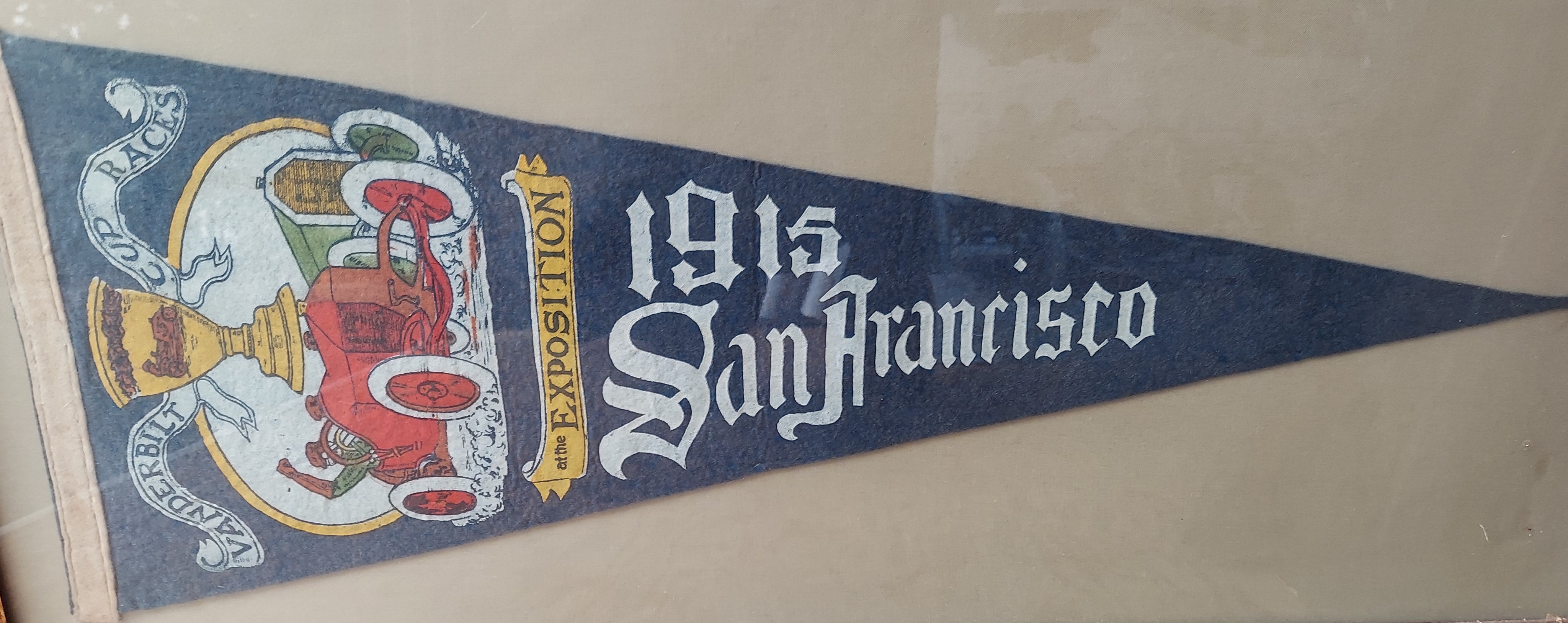
From the Howard Kroplick collection, a pennant for the 1915 races.
A 25 minute film of the Expo. The Vanderbilt Cup Race images start at 18:20.
This newsreel shows the 1915 Vanderbilt Cup Race held as part of the Panama Pacific International Exposition in San Francisco, California on March 6, 1915.





Comments
Nice post, Greg! Henry Ford had three exhibits in three different “Palaces” at the exposition. One was actually a miniature factory replicating one of his main plants (the attached ad states that 25 cars were produced there each day). The others dealt with how Ford’s profit sharing plan improved the lives of its workers and a motion picture of a Ford plant.
Additional documentation (article from Motor Age, Mar. 18, 1915).
Thanks for he additional info Art!
As I was writing this post I did think to myself if Ford actually completed and sold any cars on the PPIE ‘assembly line’. Thanks for the answer!
This is an excellent article which required a lot of research!
The Panama-Pacific Exposition clearly made a big impression on my grandfather, he painted the 1915 Grand Prize and Vanderbilt races several times, usually including the Palace of the Fine Arts in the background. I’m posting a couple of them below: The 1915 Grand Prize and one titled “1938 GP Hypothetical”.
Tim, Thanks for the compliments and the photos of your grandfather’s incredible paintings.
Included with this program, but not included in this post, was also a program for the Panama-Pacific Expo being simultaneously held in San Diego at that time. That program also had the same note written on the front as the San Francisco Expo program that he was there with his mother.
In 1990 the folks in San Francisco put on an event to celebrate the 1915 races held during the Exposition. As one of the few entrants still surviving, the 1914 Tahis Special was invited to attend. The race cars were to be displayed inside the Palace of Fine Arts rotunda and a car show was held outside on the grounds. Also the race cars were allowed to make two laps of the complete original race course. Needless to say, this was a very fun event and we got to meet a lot of interesting people.
Hi Greg,
Here’s the front cover of the official program for the 1915 Vanderbilt, showing the postponement.
Excellent addition Stuart!